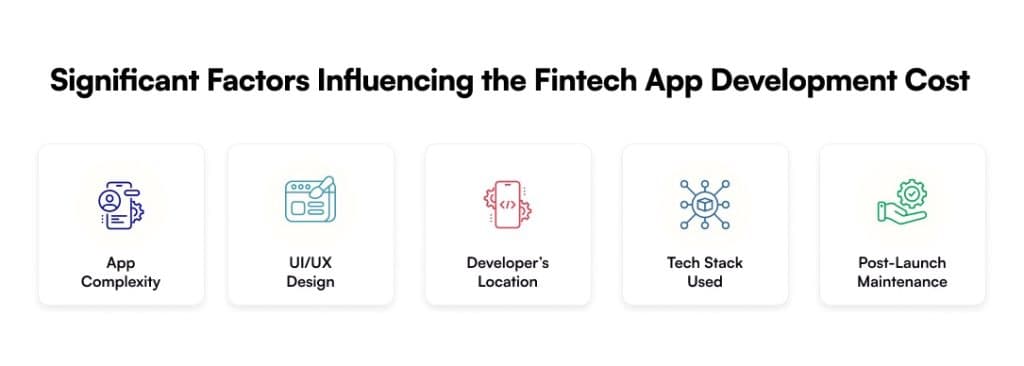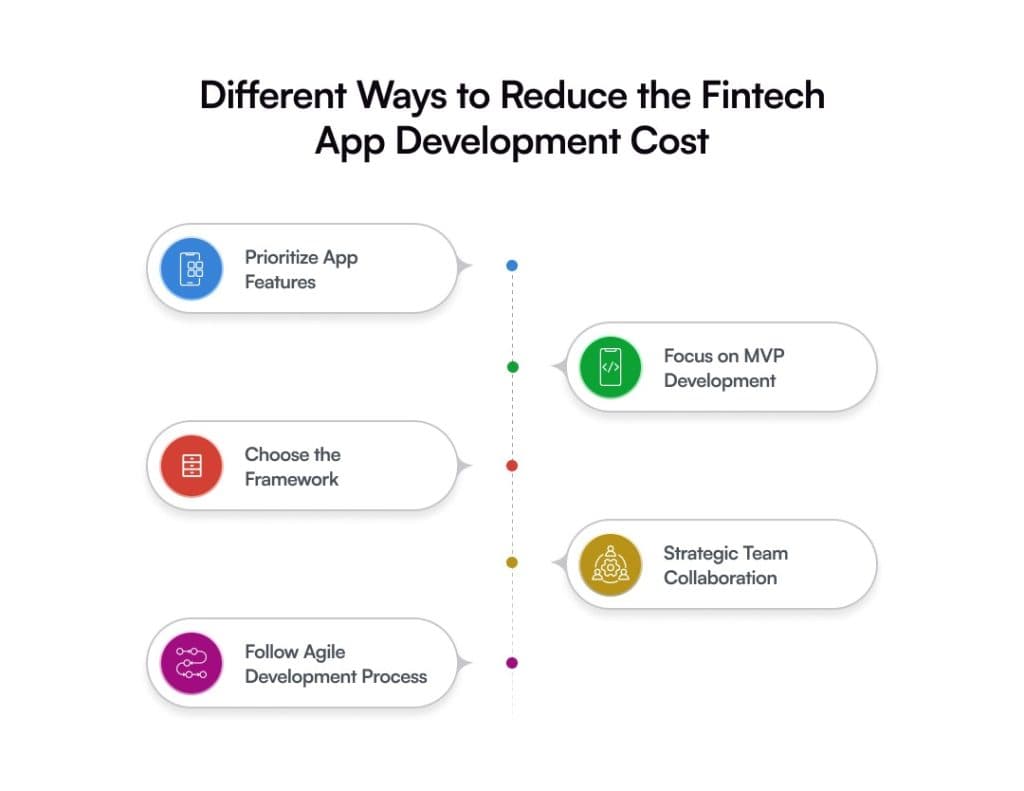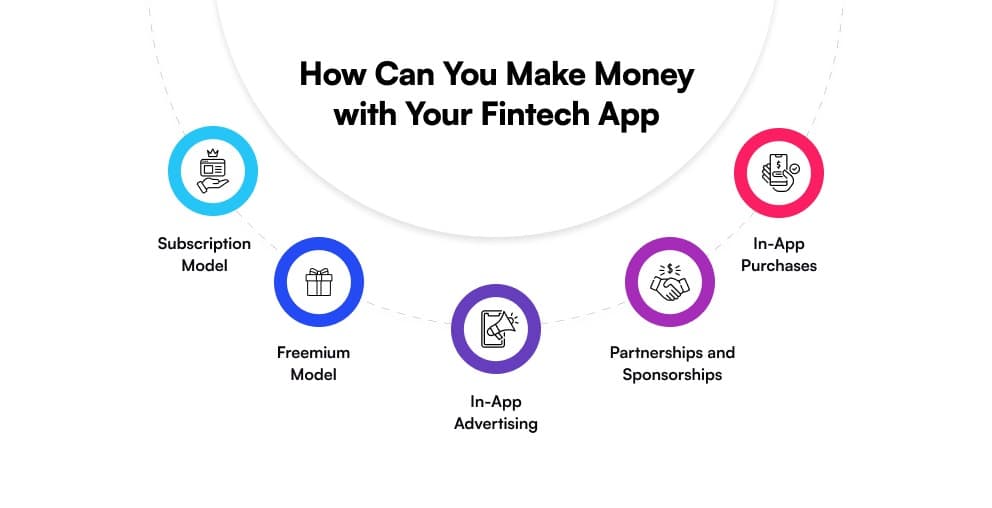The fintech market is booming at an unprecedented rate, and by 2033, its global market size will reach $1583.05 billion. Quite impressive, right? Now, as financial institutions continue to grow, understanding the overall cost to develop a fintech app becomes imperative.
But the truth is, there is no definite answer to the most asked question: How much does Fintech app development cost? There are numerous factors affecting the cost to build a fintech app, like the complexity of the app, UI/UX design, the developer’s location, and so on.
On average, the cost of building a fintech app ranges from $30,000 to $300,000 (maximum), and remember, the price will rise as you wish to include advanced features.
This blog breaks down the real cost drivers, hidden expenses, must-have features, budgeting strategies, and ROI insights. By going through this guide, you can plan your fintech app development journey wisely. So, stay tuned till the end for some useful insights:
Key Factors Affecting Fintech App Development Cost
Understanding the exact cost of fintech mobile app development depends on a wide range of factors that include:

- App Complexity
Your fintech app’s complexity level is probably the biggest factor that influences the overall cost. A simple app that has only a few features (like user registration, transaction history, and payment integration) will be significantly cheaper compared to the advanced apps.
Essentially, the development time and cost will be increased to the extent of the new features, integrations, and functionalities you add.
- Intuitive App UI/UX Design
Trust is at the core of the design in fintech. A straightforward, self-explanatory interface makes the users comfortable with handling the financial features on their own. But getting to a smooth experience demands skilled designers, interactive prototypes, and several iterations.
Hence, it contributes to the total cost. Putting money into a good UI/UX design is a way to make the brand alive with higher engagement, user retention, and long-term value.
- Developer’s Location
The location of your development team will have a major impact on the cost. Generally, developers in North America or Western Europe tend to have higher hourly rates than those in Asia or Eastern Europe.
Still, the place of a team shouldn’t be the only factor weighing in your decision; the team’s experience, their knowledge of fintech compliance, and communication quality also count a lot for the right team choice.
- Tools and Technologies Used
The technology stack supporting your app, such as frameworks, APIs, cloud platforms, and third-party integrations, is one of the main factors that determine the costs.
The use of cutting-edge technologies like blockchain, AI-powered analytics, or biometric authentication may raise the costs substantially. However, they also improve the security and the overall performance.
- Post-Launch Maintenance
Developing a mobile app is not just about launching it. Timely updates, bug fixes, performance tuning, and feature enhancements are necessary to ensure that your fintech app remains safe and attractive to users.
Setting aside some of your money (generally about 15–20% of the total development cost) for continuous maintenance and support is a smart decision.
Types of Fintech Apps and Their Average Cost
The type of fintech app you choose, whether it’s a digital wallet, trading platform, or lending app, directly impacts your project budget. Each app type has different complexity levels, security needs, and feature demands, which shape the overall development cost.
| App Type | Estimated Cost (USD) |
| Digital Wallet / Payments | $50,000 – $70,000 |
| Lending / Microfinance | $60,000 – $100,000 |
| Banking / Neobank Apps | $90,000 – $150,000+ |
| Wealth / Investment Platforms | $90,000 – $160,000 |
| Insurance / Insurtech Apps | $80,000 – $150,000 |

Hidden Fintech App Development Cost You Must Pay Attention To
Fintech app development cost includes more than just coding and designing; from licensing fees to infrastructure compliance, which business owners often overlook, but in reality, they shouldn’t.
Here is the list of 5 key aspects of hidden costs that come along with the overall cost to develop a fintech app.
| Hidden Cost | Why It Matters |
| Licensing Fees | Using banking APIs, payment processors, and implementing other integrations requires money. |
| Security Certifications | Besides that, compliance expenses are added by PCI DSS, SOC 2, and ISO audits. |
| Infrastructure Scaling | Costs of cloud auto-scaling are getting higher as your user base and data volume increase. |
| Maintenance & Monitoring | Maintenance is usually around 15–20% of the initial development cost. |
| Feature Upgrades | By adding features such as crypto wallets or robo-advisors, the expenses will go up after the launch. |
Tips and Tricks to Reduce the Fintech App Development Cost
The price of building a FinTech app depends on a number of factors and the method used. If you put in place a procedure that is well-coordinated and efficiently handled, you will be able to alleviate the difficulties in the development and thus lower the total cost of the FinTech app development.

- Prioritize App Features
The first thing you should do when you are developing a FinTech app is to figure out which features are necessary and which can be left out. By simplifying the functionalities of the app, you can lower the costs of app development as it takes less time and is less labour-intensive.
Furthermore, you will be able to add sophisticated features to your app at the next level of business growth. This way, you will be able to handle the development cost of a banking app in a more efficient way.
- Focus on MVP Development
MVP development is definitely a good way to test and confirm your app concept in the market while getting constructive feedback from users. On top of that, it is also possible to save a large portion of the development costs through this process.
By using the MVP strategy to release your app, you get the opportunity to evaluate its success and viability in the market. It is a great way to enhance your app’s features by relying on the actual data and user feedback.
- Choose the Framework Wisely
Another important tip to keep in mind when building a fintech app is picking the right technology. You can consider choosing technologies, like React Native or Flutter, which use a single codebase that works on iOS and Android.
Leverage the capabilities of ready-made components for functionalities, like payment gateways, identity verification, etc. Additionally, use cloud-based infrastructure, like AWS, Azure, or Google Cloud. It reduces upfront hardware investment and offers scalable pricing models.

- Strategic Team Collaboration
By delegating your work to a trusted FinTech mobile app development firm, you can team up with experts who have a deep knowledge of the subject. Such companies have teams of experienced developers who will do your work properly and at a lower price.
Consequently, your program will be able to utilize systematic governance and open dialogue during its total period of evolution. Being able to choose from a large number of companies, you can find one that suits your financial needs.
- Adopt Agile Development Process
Iterative builds are less wasteful, faster in delivering, and cheaper in terms of rework. By using Agile methods, your team can be very flexible with user feedback, take care of bugs while the work is going on, and make sure that the end product is really what the market requires.
Top Monetization Models for Your Fintech Mobile App
So, you came up with an app idea and a budget, but the question remains: how will your fintech app generate money? Here are some of the best monetization models that would not only make your fintech solution profitable but also a sustainable revenue stream.

- Subscription Model
This model enables users to keep on paying for premium financial tools or exclusive services by a recurring fee. This is a monthly or yearly payment. It is an ideal model for apps that provide value on a continuous basis, like analytics, portfolio tracking, or lending insights.
- Freemium Model
Want to grab the attention of more users from the start? Just provide the basic features for free and place the advanced functionalities in a paid section. Such a model allows users to familiarize themselves with the value of your app before they make a money-worthy decision, thus increasing conversions gradually.
- In-App Advertising
In-app advertisements are, by far, one of the most efficient methods to monetize an application, particularly when there is a large user base. The main thing that matters here is the equilibrium. Ads should be made relevant and less intrusive so that users remain engaged; thus, you are paid either by the number of impressions or clicks.
- Partnerships and Sponsorships
Collaborations could be a great source of power in fintech. Working together with banks, insurance providers, or financial brands may lead to the creation of new revenue streams. As a result, it enables the company to gain the trust of the users even more.
- In-App Purchases
Give users the freedom to pay for the things they really value. If it is premium analytics, an expert consultation, or a sophisticated investment tool, in-app purchases allow you to turn the engagement into revenue without putting a limit on free users.
Develop a Fintech Mobile App with Galaxy Weblinks without Breaking the Bank
For each business owner, knowing the actual cost of fintech app development is the initial step that leads to more wise investments. It is a chain where each decision you make, from selecting the appropriate platform and app type to adding necessary features, affects not only your budget but also your app’s success.
With Galaxy Weblinks, you don’t have to navigate these decisions alone. Our experts are there to guide you at every step and help you build a fintech app that aligns with your vision, market goals, and most importantly, budget.
So, give us a call and let’s bring your app idea to life!
FAQs
Q. How much does a fintech app development cost?
A. The price of creating a fintech app with an easy payment system varies based on the app’s complexity and the number of features. A basic app with minimum complexity might cost approximately $80,000. To get an estimated quote for your fintech app development, feel free to contact our team.
Q. How long does it take to build a fintech app?
A. It usually takes 3 to 6 months to develop a standard Minimum Viable Product (MVP) version of a mobile banking app. When more features are added, the time to develop the app can be stretched up to around 9 to 11 months.
Q. How can startups get a budget-friendly fintech app development?
A. Startup companies can cut down their expenses through an initial MVP launch, the use of reusable components, cloud infrastructure, and collaboration with a skilled fintech mobile app development company that is efficient in mistake management.